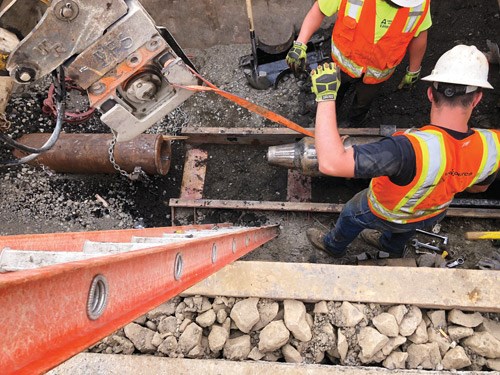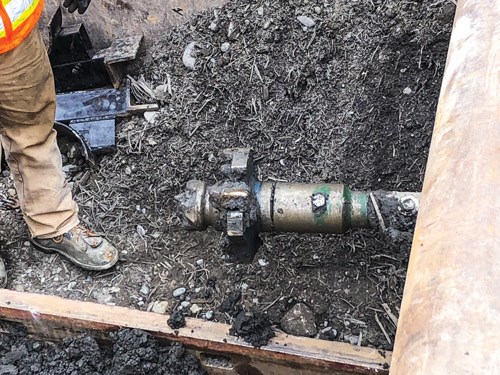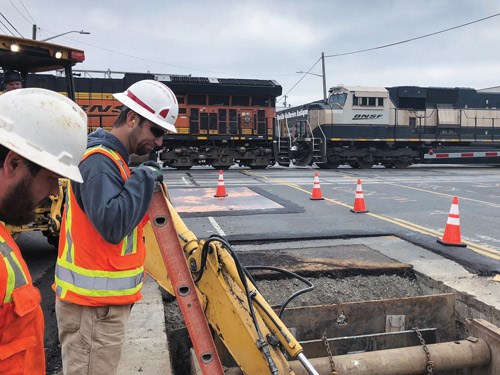May 2019 Vol. 74 No. 5
Features
Hidden Beneath the Bed
Undocumented Obstacles Below Railroad Tracks Complicate Ramming Job

To casual observers, modern railroad tracks appear to be nothing more than steel rails nailed to wooden crossties in the ground. However, below the rails and crossties lie carefully constructed systems providing stability and support for the massive loads of passing trains designed to efficiently disperse the forces into the subgrade.
Excavating through the formation completely stops all rail traffic on that section, from project start to end. It also compromises the integrity of the formation, posing the threat of eventual, catastrophic failure causing train derailment.
That’s why railroad companies generally permit only trenchless installation methods, trusting the work to specialists like Kinnan Engineering Inc. of Camas Valley, Ore. Keith and Diana Kinnan founded the company in 1995 as a separate contracting service from its Underground Technologies division, an underground technologies tooling manufacturer at that time. Utility installations are a Kinnan specialty offered to customers throughout its nine-state, West Coast service area, which includes Alaska.
A 2018 job for a Kinnan utilities customer required the installation of 120 feet of 12-inch-diameter gas line 6-to-7-feet beneath parallel tracks in the SODO district of Seattle. SODO is a unique mix of recreational areas, stores, restaurants and entertainment venues amid office and industrial complexes.
Don Carter, who heads up Kinnan Engineering’s jack-in-bore and pipe-ramming operations, said at first this job had seemed to be a routine installation. Kinnan has done hundreds of railroad crossings over the years, many of larger diameter and greater distances.

Selecting correct tech
Kinnan Engineering is expert in many trenchless technologies, and Carter said railway companies most often let Kinnan decide which trenchless method to use, so long as it meets the railway’s stringent job requirements. In ground conditions conducive to boring, Kinnan will auger in the lines. But when there are running sands, such as this one, the company employs pipe ramming techniques. Once in a while, a railway will even specify a job be done using only the pipe ramming method.
“We’ve been doing pipe ramming many, many years and own an array of equipment from the top manufacturers,” said Carter. “We even use a hammer now in combination with our auger-boring jobs. Right now, in fact, we have a 10-inch hammer on a drilling job, both hammering in and pulling with it.”
Carter especially likes the 10-inch ramming tool, made by HammerHead Trenchless of Lake Mills, Wisc. “That thing hits hard,” he said. And he likes working with Cameron Zoucha of Ditch Witch West, his trenchless dealer, and Jim Moore, HammerHead regional manager of rehab and replacement.
On this 12-inch-diameter Seattle installation, Kinnan used a 12-inch HammerHead ramming tool in a technique called “slick boring.” The method consists of first ramming a dummy pipe the same diameter as the gas line product, from one side to the other. The crew welds the gas line to the rammed pipe’s end. As the dummy pipe is extracted from the hole, the new gas line simultaneously slides into its place. Throughout the process, the bore hole’s walls are held intact by pipe.
This job’s first complication was permitting. According to Carter, the project’s start had been delayed three times while waiting for the okay to begin, with all equipment and personnel on the site ready to go.
Project foreman Israel Wafer said another complicating factor was the restricted daily work window due to particularly heavy railway traffic and vehicular congestion. Commuter traffic flows in downtown Seattle are particularly busy in the morning and afternoon. Therefore, operations could not start before 9 a.m. and had to cease for afternoon traffic by 3 p.m. each day.
All locates had been done in advance. When permitting came through, with no apparent obstructions or utilities in the bore path, Kinnan dug a 30-foot-long, 8-foot-wide working pit at a depth of about 7 feet and set up standard certified 20-foot steel shoring boxes with 8-foot spreaders. It was all the room needed to accommodate the 8-foot-long, 12-inch ramming tool and the 20-foot lengths of casing.
Calm before the storm
The first two sticks went in without a problem, Carter said. Each took just eight to 10 minutes to drive. Time between the sticks to weld the second one on, reattach the hammer and continue driving casing took less than an hour.
While driving the third length of pipe, the casing stopped advancing. It was recoiling with each impact. The abrupt change in sound indicated the pipe was hitting something other than the soils they had been ramming through.
Crew members stopped operations to investigate the obstacle. They removed the ramming tool and gear, set their boring machine on the ramming tool’s guide rails and augered spoil from the pipe. When they sent a camera to the other end, they discovered they had struck a wooden pier dead center. They determined it to be the buried remnant of a trestle.
Kinnan met with the general contractor, the railway and the utility owner (the customer) to discuss the three ways they could proceed. They could offset the bore path and begin with the 12-inch casing again 6 to 8 inches to the side. Or they could swallow the 12-inch casing with a 36-inch pipe, which would be able to punch right through the wooden pier. Another option would be to fabricate a tool to cut the wooden pier out of the casing’s path, then continue ramming operations.
Future construction plans required the line’s path to remain as specified. The owner and general contractor favored cutting away the pier to continue as planned. Carter and Wafer modified a standard rock-cutting head to make it an efficient wood-cutting tool for the augering machine. The tool’s design included the ability to expand once it exited the 12-inch casing and retract again to facilitate its retrieval. It worked perfectly, cutting a hole wide-enough to permit the casing to easily pass through. Crew members backed the tool out of the casing and resumed pipe ramming operations.
Not long after they had started, they ran into a second pier. Once again, they pulled the ramming tool away and repeated the cutting process.
When they resumed pipe ramming operations for the third time, advancing the pipe to 80 feet, they were stopped again. This time the sounds coming from the pipe were different than before. They backed away the ramming tool and collet once again to set their auger on the rails, remove spoil from the casing and send a video camera down to inspect the obstacle. This time the hole was blocked by a discarded manhole cover. Not far from it, they learned, was an abandoned, reinforced-cement manhole.
Starting over
If they were to stay on the specified bore path, the only option left was to dig the manhole out. They had advanced the pipe clear of the track above it by 15 inches, but the railway would not permit them to excavate through the bed’s formation.
That left just one alternative. Kinnan must offset the bore path and begin again, staying as close as possible to the original specification. The crews left the 12-inch casing in place, filled it with grout, and moved ramming operations two feet to the side to miss the steel obstruction and the wooden piers. As an extra precaution to avoid a submerged pipe associated with the abandoned manhole, they modified their pit, giving it a downward grade of 3 percent.
Kinnan crews sent the dummy pipe across this time without any issues. They pulled the pipe back using their auger-boring machine, completing the gas line installation for their customer despite the repeated complications, entirely within the daily work window and without ever interrupting railway or commuter traffic.
It isn’t the first time Kinnan found hidden surprises beneath the tracks, many posing daunting obstacles for those less-familiar with railroad applications. Mike Walk, a pipe-ramming application expert with HammerHead Trenchless, said even the use of ground-penetrating radar (GPR) cannot adequately identify whether an object in the pipe path would stop a pipe-ramming operation. Nor is it a common practice to employ GPR in railway crossing jobs.
Regardless of the preliminary documentation they receive and their own routine exploration of a planned bore path, trenchless pipe installers around the country have found everything from discarded appliances to entire buried boxcars. “You just never know what you’ll find beneath tracks,” Carter said.
While these may pose formidable obstacles for those less familiar with railroad applications, in over 20 years of trenchless installation, the obstacles that Kinnan crews have encountered have never resulted in failure to complete an installation.
Carter said that Kinnan may, indeed, one day encounter subsurface obstacles that may prove impossible to overcome. However, he is confident that any pipe-installation contractor competent in a wide variety of trenchless methods and using quality equipment matched to the specific job will find a way to complete almost any pipe-ramming project. Experience and capability of on-the-spot innovation boost expectations of success. •





Comments